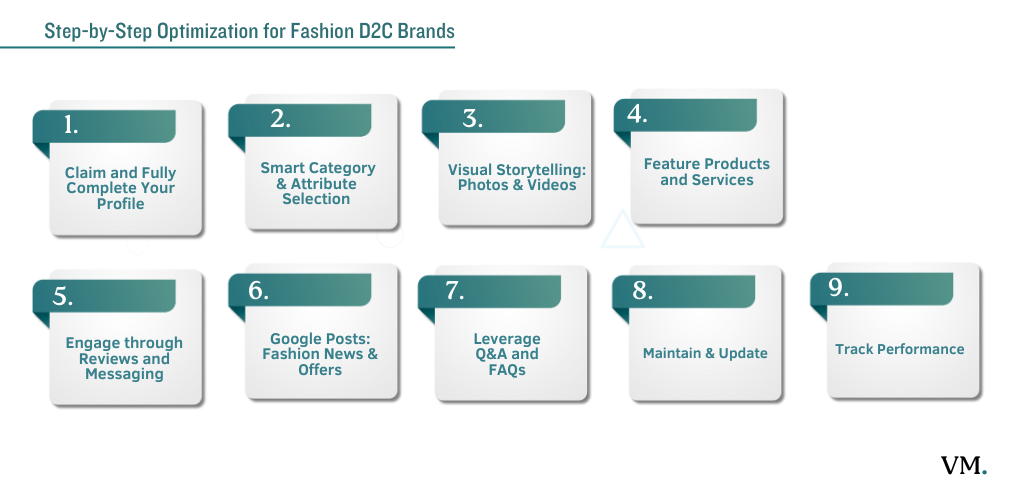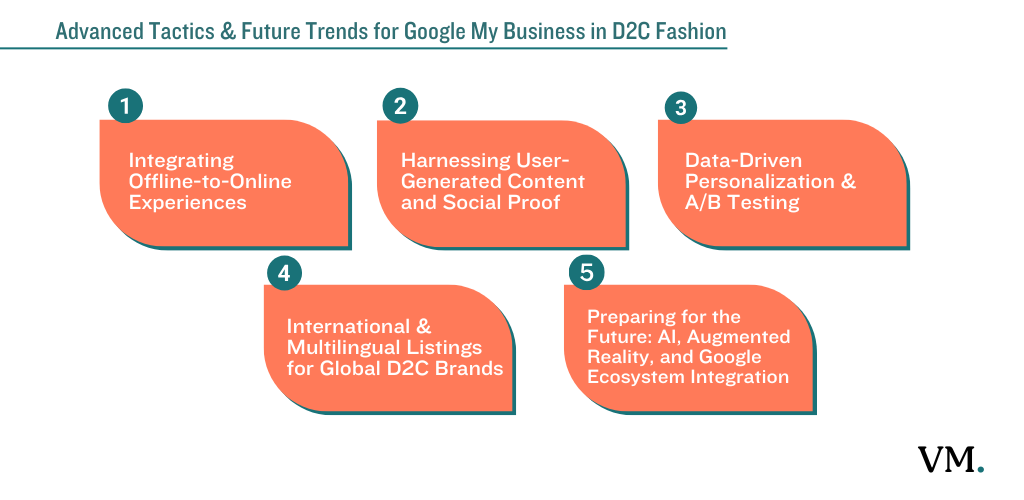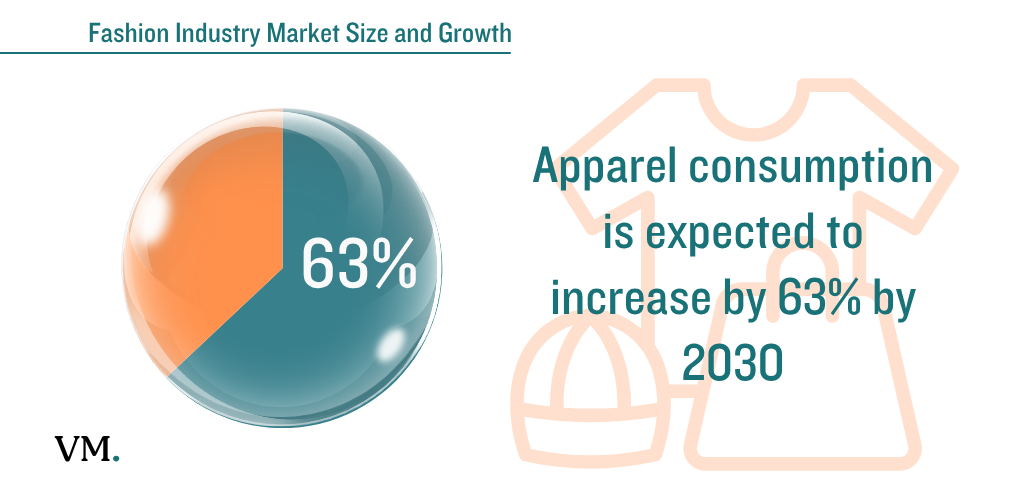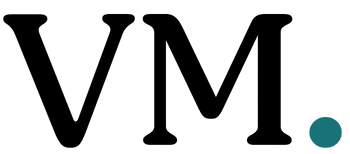Let’s explore Google My Business optimization for D2C fashion brands. Direct-to-consumer (D2C) fashion brands are thriving because of their deep connection to customers, unique products, and digital-first strategies. Yet, many overlook a crucial (often free) tool for driving local visibility, reputation, and sales: Google My Business (now known as Google Business Profile). Here’s an up-to-date guide—tailored for D2C fashion brands—on maximizing this powerhouse platform in 2025.
Why Google Business Profile Matters for D2C Fashion Brands
- Local Discovery: Google Maps and local search surfaces your brand in front of high-intent shoppers browsing “near me” or searching for specific products.
- Brand Experience Control: Unlike marketplace listings like Amazon, your profile lets you curate images, offers, and your brand’s story.
- Trust & Social Proof: Ratings, reviews, and engagement on your profile influence nearby customers and boost your online authority.
Step-by-Step Optimization for Fashion D2C Brands

- Claim and Fully Complete Your Profile
- Ensure every field is filled in: business name, address, phone, website, business hours, and description. Make sure your name, address, and phone (“NAP”) information match what’s on your website and elsewhere online.
- Write a keyword-rich description that naturally incorporates what makes your brand unique, e.g., “sustainable streetwear in LA” or “inclusive women’s denim.”
- Choose Specific Categories & Attributes
- Select the most accurate primary category (e.g., “Clothing Store,” “Women’s Fashion Store”).
- Add all relevant secondary categories and business attributes such as “Black-owned,” “LGBTQ+ friendly,” or “Women-led,” so your brand stands out and connects with values-driven shoppers.
- Prioritize Visual Storytelling
- Regularly upload high-quality images of your storefront, collections, designs, customers (with permission), and your process.
- Add video content—like design previews, styling sessions, or behind-the-scenes moments—to bring your personality to life.
- Showcase Products Directly
- Use the product catalog feature to add your bestsellers, new arrivals, or exclusive drops. Include detailed descriptions, prices, and direct purchase links.
- Keep inventory updated—especially after new launches—to ensure accuracy for online and local shoppers.
- Proactively Manage Reviews and Messaging
- Ask shoppers (online and in-person) to leave reviews. Consider adding QR codes to product packaging or receipts to facilitate reviews.
- Respond to all reviews with gratitude, professionalism, and solutions when issues arise.
- Enable direct messaging to quickly answer sizing questions, styling advice, or order inquiries.
- Leverage Google Posts and Events
- Use Google Posts to announce product launches, pop-ups, sales, or collaborations.
- Share helpful content like style guides or news about sustainability initiatives to build authority and connection.
- Engage with Q&A and FAQs
- Answer common customer questions proactively: sizing, returns, store pickup, etc.
- Regularly monitor and respond to new questions posted by customers on your profile.
- Keep Information Current
- Audit and refresh your business hours, photos, and offers during holidays, events, or sales periods.
- Regularly review competitor profiles for inspiration and best practices.
- Track Performance and Refine
- Use Google’s insights and “Performance” dashboard to see how people find you and what actions they take. Adjust your description, images, or product listings accordingly.
Special D2C Tips:
- Highlight what makes your brand “different”—sustainability, limited-edition drops, local production, or celebrity customers—on your profile and in posts.
- Link your Google Profile with your e-commerce platform (like Shopify) if possible, for inventory accuracy.
- Announce and promote local events for increased brand exposure and in-person engagement.
A thoughtful, consistently updated Google My Business profile not only boosts local search visibility but also builds trust, drives sales, and amplifies your distinctive brand voice in the D2C fashion space.
Advanced Tactics & Future Trends for Google My Business in D2C Fashion

1. Integrating Offline-to-Online Experiences
Go beyond static listings by tying your in-store activity to your online profile. For example:
Hyper-local inventory updates: Use tools or integrations (like Pointy by Google) to let shoppers know what’s available right now in each location.
Event check-ins: Host pop-ups, workshops, or styling sessions and encourage attendees to check-in or post about their visit. These user-generated posts and photos can boost your local relevance and appear in Maps results.
Showcase unique in-store experiences: Use the ‘Highlights’ and ‘From the business’ sections to detail custom fittings, alterations, or instant personalization services offered only in-person.
2. Harnessing User-Generated Content and Social Proof
Photo Tag Campaigns: Ask customers to tag your business on Maps or upload their own photos via your Google Business Profile. Incentivize with contests or small rewards—this crowdsourced content increases engagement and authenticity.
Leverage customer Q&A: Encourage shoppers to answer each other’s questions publicly, not just owner-answered FAQs. This builds a community vibe around your listing and shows vibrant shopper interaction.
3. Data-Driven Personalization & A/B Testing
Experiment with keyword variations: Try different descriptors and product highlights in your Business Profile description, changing them seasonally (e.g., “holiday party dresses,” “spring streetwear drop”), then monitor which keywords attract more views and interactions via the Insights dashboard.
Track post types: Rotate between event posts, product highlights, and editorial content (like style tips). Compare engagement rates to determine what your audience values most and adjust your content calendar accordingly.
4. International & Multilingual Listings for Global D2C Brands
Multi-language support: If your fashion D2C brand serves multiple regions or languages, utilize Google’s support for multilingual descriptions, posts, and attributes. Populate these fields so international shoppers see info in their preferred language.
Location group management: For brands with several showrooms or pop-up addresses, manage all locations from a single dashboard and tailor each local listing with geo-specific offers, imagery, or staff profiles.
5. Preparing for the Future: AI, Augmented Reality, and Google Ecosystem Integration
AR previews: Stay alert for beta features (like Google’s experimental AR in Maps) that will soon allow shoppers to “try on” products virtually or preview your store’s interior before visiting.
Integrate with other Google services: Link your Business Profile to your YouTube channel for direct video showcases or to Google’s new shopping features for “buy direct” callouts in search.
Voice search optimization: Add natural, conversational keywords to your descriptions and posts to improve compatibility with voice-activated searches, which are rising for local retail queries.
Key Statistics on Google My Business Optimization and the Fashion Industry in 2025

Understanding the latest industry statistics helps D2C fashion brands gauge the significance and potential impact of optimizing their Google My Business (Google Business Profile) presence in 2025 and beyond.
1. Fashion Industry Market Size and Growth
The global apparel market is valued at approximately $1.84 trillion in 2025, accounting for about 1.6% of the world’s GDP. This demonstrates the massive scale and economic importance of the fashion sector globally.
The United States remains the largest apparel market worldwide, with a size of $365.7 billion in 2025. As the largest individual market, local visibility through Google Business Profile in the US is a critical channel for brands.
Apparel consumption is expected to increase by 63% by 2030, stressing the rising demand and opportunity for fashion brands to capture consumers’ attention locally and online.
2. Digital and Local Search Behavior Insights
Despite the explosive growth of online shopping, 58% of consumers still prefer to shop for apparel in-store, underscoring the importance of local search optimization for driving foot traffic via Google My Business.
Around 80% of fashion consumers express dissatisfaction with online search results due to irrelevant matches, creating a barrier to purchase. This makes an optimized Google Business Profile essential for attracting qualified local traffic directly to your brand.
69% of customers go directly to a retailer’s onsite search bar to find products, indicating that relevance of local and on-site content is paramount for conversion. Well-optimized local profiles help funnel these shoppers more efficiently.
3. Consumer Discovery and Engagement Trends
In 2025, 38% of customers prefer discovering fashion brands through social media, closely competing with 37% who use traditional search engines like Google. This highlights the complementary role of Google Business Profile alongside social channels.
50% of fashion executives see generative AI as a key tool in product discovery, while 82% of customers want AI assistance to reduce time spent researching products. Google’s AI-powered local search relevance can amplify brand discovery for D2C fashion brands.
4. Ecommerce and Online Presence
The global fashion eCommerce market is projected to reach $1.25 trillion by 2024, growing at a compound annual growth rate (CAGR) of 8.3% through 2028. This growth signals increasing competition online but also rising synergy with local online listings like Google Business Profile.
Among the top direct-to-consumer brands globally, 13 of the top 20 operate in fashion and apparel, indicating the dominance and importance of the D2C model in fashion retail. Optimizing Google My Business is critical for these brands to convert local interest into sales.
5. Local Reviews and Consumer Trust
Google My Business profiles rich in reviews and active engagement experience significantly higher customer trust and conversions. While exact numerical data for review impacts vary, brands responding promptly to reviews and enabling direct messaging see measurable uplift in foot traffic and online sales. [Derived industry practice]
These statistics provide strong evidence that fashion brands leveraging Google My Business to enhance local visibility, showcase products, and engage with consumers through reviews and posts can tap into a large, spending, and digitally savvy market. Optimized Google profiles stand as an essential pillar for D2C fashion brands aiming to grow their local footprint and complement their expanding online sales in 2025.
Wrapping It Up
In a crowded D2C market, even digital-first fashion brands benefit immensely from local discovery and trust signals provided by an optimized Google Business Profile. Treat your Google listing as a living, evolving touchpoint—showcasing your latest collections, brand values, and commitment to top-tier customer service.
A consistently optimized profile does more than draw foot traffic or calls—it builds your brand’s reputation, fuels local SEO, and turns Google into an effortless extension of your showroom in 2025’s shopping ecosystem.
FAQ
What is Google My Business (Google Business Profile) and why should D2C fashion brands care?
Google Business Profile is a free tool that lets businesses manage how they appear in Google Search and Maps. For D2C fashion brands, it enables increased local visibility, control over your brand narrative, and opportunities to engage local shoppers.
How do I claim and complete my Google Business Profile?
Visit the Google Business Profile website and follow the steps to verify your business. Fill out every field: name, address, phone, website, hours, and business description. Make sure your business details are consistent anywhere they appear online.
What categories should I select for my fashion brand?
Choose categories that describe your offerings most accurately (e.g., “Clothing Store,” “Fashion Designer,” “Women’s Fashion”). Add relevant attributes such as “Women-led” or “Sustainable” to help your brand stand out.
How important are photos and videos?
Very important. High-quality photos of your storefront, collections, and happy customers build trust and make your profile inviting. Videos showing your design process or styling tips help bring your brand to life.
Can I list products on my Google Business Profile?
Yes. Use the product catalog feature to showcase featured items, bestsellers, and new arrivals. Include details like price, description, and a purchase link to your website.
Q6. How do I get more reviews and what should I do about negative ones?
How do I get more reviews and what should I do about negative ones?
Encourage every customer to leave a review—add QR codes on receipts or packaging linking to your profile. Respond to every review, thanking happy customers and addressing concerns politely and helpfully in negative reviews.
What are Google Posts and how should D2C brands use them?
Google Posts let you share updates, events, sales, and new product launches. Use them to promote limited-time offers, pop-ups, blog posts, and stories that highlight your brand’s identity.
How do I keep my profile information up to date?
Set calendar reminders to regularly review and update your listing—especially before launches, sales, or local events. Refresh your photos and hours seasonally or whenever you have changes.
Is it possible to use Google My Business if I sell only online?
Yes—if you have a central business address or host pop-ups, Google still lets you connect with nearby shoppers searching for your brand, products, or style niche.
How can I measure my profile’s performance?
Use the Insights/Performance dashboard in your Google Business Profile to track searches, views, and actions taken. Adjust your strategy based on what content gets attention and which products attract views.
Any other tips for D2C fashion brands?
Highlight what makes you unique (sustainability, exclusivity, ownership approach) in your description and posts.
Connect your listing with your e-commerce platform for real-time inventory.
Regularly check your competition’s profiles for new ideas or inspiration.



